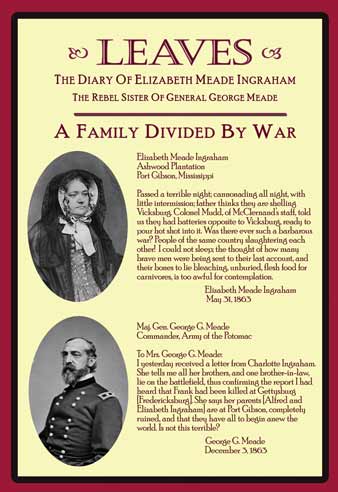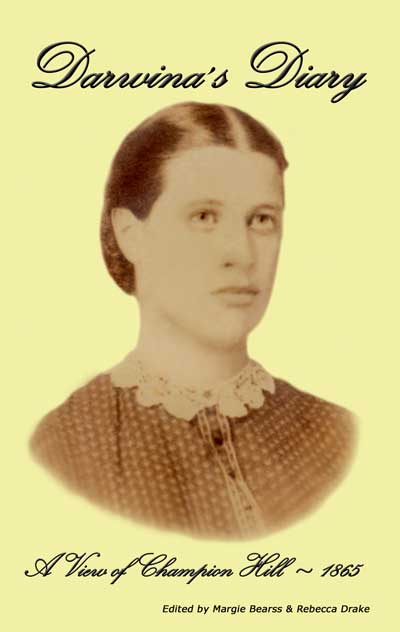|
Champion Heritage Foundation Books & Gifts
~ LEAVES ~
THE
DIARY
OF
ELIZABETH
MEADE
INGRAHAM The Rebel Sister of General George Meade Edited by Sue Burns Moore and Rebecca Blackwell Drake
~ Preface ~ | |||
|
Around 1840, Alfred and Elizabeth Ingraham moved from Philadelphia, Pennsylvania, to Claiborne County, Mississippi, where Alfred managed the banking interests of the Grand Gulf & Port Gibson Rail Road Company. The family settled on a large section of land ten miles east of Port Gibson in a community known as Willow Springs. The land they purchased was accentuated by a continuous flow of ridges and deep ravines. Here, on the crest of a hillside, they either bought or built a magnificent mansion which they named Ashwood. The Ingrahams were attracted to the area since Willow Springs was located at a major crossroads. A maze of roads led in different directions: north to Hankinson’s Ferry and Vicksburg, west to Grand Gulf, east to Jackson and south to Port Gibson and Natchez. The property also had access to rivers and creeks. Approximately one mile south was the Big Bayou Pierre which provided rich bottomland for planting. To the north, bordering the Ingraham property, was Kennison Creek, a scenic stream which also watered fertile land. Further north was the Big Black River where Hankinson’s Ferry crossed into Warren County — the main route to Vicksburg. On April 30, 1863, Union forces under the command of Maj. Gen. U. S. Grant, crossed the Mississippi River and landed at Bruinsburg. Spearheaded by McClernand’s XIII Corps, the Union engaged Bowen’s Confederate forces in the Battle of Port Gibson on May 1. Elizabeth defined the battle as “one long and continuous fight,” a fight which included |
numerous smaller battles: A. K. Shaifer House, Magnolia Church, Willow Creek, and Parkinson’s Hill. Anticipating that their plantation would soon be in danger, the Ingrahams sent their daughters — Alice, Apolline and Jane — to Vicksburg for safety. On May 3, the Union army began arriving at Willow Springs. Generals McPherson and McClernand made Ashwood their headquarters where they dined in luxury and slept in the finest of beds. When the Yankees marched on, the Ingrahams were left with few livestock and most of their possessions had either been stolen or destroyed. The only room in the house that was not totally plundered was Elizabeth’s bedroom. This was perhaps due to the fact that the vandals discovered that she and Alfred were Northerners. It is also conceivable that Elizabeth informed the invaders that her brother was Union General George G. Meade, commander of the V Corps, Army of the Potomac. After occupying Ashwood for ten days, the Union army marched on to Raymond, Jackson, Champion Hill, Big Black River and finally to the rear of Vicksburg. On July 4, 1863, following a lengthy siege, the Confederates surrendered the city. As Grant and the Northerners celebrated the fall of Vicksburg, the Ingrahams wept. They wept for family and friends killed in the war. They wept for the loss of house and property. They wept as their dreams for the future were erased. And, as they wept, they asked, “What will become of us?” Rebecca Blackwell Drake |
||
|
$20.00 + $5.00 S/H
| |||
|
My Dear Wife ~ Letters
My Dear Wife ~ Letters to Matilda
tells the story of a family whose lives were forever changed as a
result of the
As Grant and Sherman threatened Vicksburg, Sid found himself caught up in the excitement of war. In spite of Matilda’s protests that he was too old to have enlisted, Sid chose to remain in the army and to fight for the Cause. In 1863 as Grant’s army marched for Vicksburg, the Champion plantation became the scene of one of the bloodiest and hardest fought battles of the war. Matilda’s grief was amplified when the Yankees torched her house, leaving it in smoldering ruins. Anguished over the loss, Matilda speculated, “I have always looked on the dark side of this war and what the end will be is beyond human comprehension.” Her fears were soon realized when Vicksburg fell to the enemy and Sid was taken prisoner. Seven months later the regiment was ordered to Georgia to begin yet another campaign. During the Atlanta Campaign, Sid’s hopes were dashed when the Confederate Army, commanded by John Bell Hood, was ‘outgeneraled’ by Sherman and Atlanta fell to the Union. During this time, Matilda read the local papers to learn the names of the wounded and the dead. She cringed in fear of finding Sid’s name among those listed. Sid’s final campaign was the Tennessee Campaign fought in November and December of 1864. Sid was still hopeful that the South could be victorious but instead the Confederate Army was all but annihilated during the Battle of Franklin when 3,000 Confederates, including six generals, were killed or wounded. Sid S. Champion was one of the last of the intrepid warriors. He was mustered out of the army in May 1865 and returned to Matilda. They rebuilt another house at Champion Hill and prepared to resume their lives but Sid died three years later, leaving Matilda a widow at the age of 38. What Matilda endured as a result of the war is a story that reads like Gone With The Wind. The letters tell of a couple caught up in the passion of war, eventually losing everything they held dear, including each other.
$25.00 + $5.00 S/H
In Their Own Words: Soldiers Tell the Story of the Battle of Raymond by Rebecca Blackwell Drake tells the story of the Battle of Raymond based on numerous old diaries, old newspaper articles, rare and out of print books, and historical data. The book features diaries and first hand accounts of the soldiers as well as photographs of men who fought in the Battle of Raymond. $20.00 + $5.00 S/H
A Soldier’s Story of the Siege of Vicksburg, by Osborn H. Oldroyd was first published in 1885, gives a sixty-five day account of the Vicksburg Campaign beginning May 1, 1863, after Grant landed his army on the east bank of the Mississippi River, and ending July 4, 1863, with the surrender of Vicksburg.
The Personal Diary portion of the book, as well as the Author’s Preface and the Introduction by Maj. Gen. M. F. Force, was edited by Rebecca Blackwell Drake and has been reprinted. The Diary provides a fascinating account of Grant's march from Bruinsburg to Vicksburg. Sixty-five captivating entries shed light on the events that happened as Oldroyd marched with the Seventeenth Corps on the long and hard march inland.
$20.00 + $5.00 S/H |
Collected Stories of the Vicksburg Campaign By Margie Bearss and Rebecca Drake
During the Vicksburg Campaign, as with all other battles, there are stories of the people to be told – stories which project human drama resulting from the scourge of war. Many of the stories have been passed down in families from one generation to the next while other accounts are found in books, diaries and letters written during and after the war. $25.00 + $5.00 S/H
Darwina's Diary: A View
Darwina’s Diary,
edited by Rebecca Drake and Margie Bearss
relates the experiences of Darwina Loud, a young
woman who traveled South in 1864 to help in the field of black
education. Unaware of the difficult situation awaiting her, she
approached
the journey with optimism and determination - optimism that the trip
south would open new doors and determination to make a difference Afraid that she would forget the day-to-day experiences of life at Midway Station, Darwina began to keep a little journal of daily events: “Perhaps, it will be pleasant to sit down and look over these pages and see just how ‘life in a tent’ here among the swamps and woods of Mississippi - in the lonely camp of a regiment of black soldiers - seemed like while it was passing. And, here, in this wild military life, each day seldom fails to bring its own pleasures and adventures.” The diary reads like a verbal painting as Darwina captures the sights and sounds of Midway Station. The area would later become known as Champion Hill.
$25.00 +$5.00 S/H
Lone Star General: Hiram Bronson Granbury by Rebecca Blackwell Drake and Thomas Holder tells the story of a Confederate soldier who was torn between two passions - fighting for the Confederate Cause and caring for his terminally ill wife. To Fannie he had pledged, “To love and to cherish until death do us part,” and to the Confederate army he had pledged to serve “Three years or the war. Granbury married Fannie Sims Granbury, a 20-year-old beauty from Alabama. She would follow Hiram from battlefield to battlefield and from prison to prison before she was stricken with cancer and died at the age of twenty-five. Following Fannie’s death, Granbury served as commander of the 7th Texas Infantry in the battles of Raymond, Chickamauga, and Missionary Ridge. On February 29, 1864, he was promoted to brigadier general and given his own command, Granbury’s Brigade, comprised of all Texas regiments. General Hiram Granbury was one of the six Confederate generals killed at the Battle of Franklin.
$25.00 + $5.00 S/H |
||
|
Send order and a check made payable to :
Rebecca Drake For information e-mail: RBDrake@comcast.net | |||
|
| Home | Grant's March | Pemberton's March | Battle of Champion Hill | Order of Battle | Diaries & Accounts | Official Records | | Killed & Wounded | History | Re-enactments | Book Store | Battlefield Tour | Visitors | Copyright (c) James and Rebecca Drake, 1998 - 2020. All Rights Reserved. |


 Civil War. Sid S. Champion, a
38-year-old plantation owner, was determined to join the Confederate
Army in spite of the protests of his wife, Matilda, who was 34 years old
and the mother of four young children. Sid was persuasive. He argued
that the war would be brief and that the South would be victorious.
Civil War. Sid S. Champion, a
38-year-old plantation owner, was determined to join the Confederate
Army in spite of the protests of his wife, Matilda, who was 34 years old
and the mother of four young children. Sid was persuasive. He argued
that the war would be brief and that the South would be victorious.



